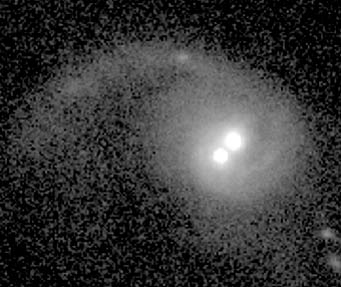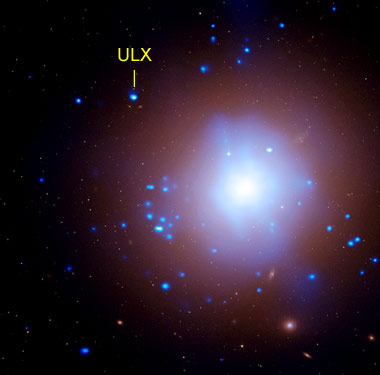At the American Astronomical Society (AAS) meeting now under way in Washington, DC, several teams of astronomers have announced new advances in understanding the giant black holes that inhabit the centers of nearly all large galaxies. And one group has announced the first evidence of a star being ripped apart by a medium-sized black hole, a variety that astronomers have not been sure exists.

This image, taken with Hubble's Advanced Camera for Surveys, clearly reveals that the faint, distant galaxy COSMOS J100043.15+020637.2 has two bright nuclei. The tidal tail of stars to the left shows that the galaxy recently merged with another, which apparently brought along its own supermassive black hole. Spectra of the two nuclei show that they have different radial velocities. They'll eventually spiral together and combine.
Julia Comerford
The problem is, astronomers have searched nearby galaxies for double black holes for many years and have only found a handful of convincing candidates. But at a press conference Monday at the AAS, a group led by Julia Comerford of the University of California at Berkeley announced 33 galaxies that have two. “We have discovered 33 pairs of these waltzing supermassive black holes,” she said. “This result is significant because it shows us that they are much more common than previously known from observations.”
All but one of the pairs come from an analysis of several thousand very distant galaxies observed in the DEEP2 Galaxy Redshift Survey (the other comes from the COSMOS galaxy survey). Many of these have supermassive holes that are actively swallowing gas, making their surroundings shine bright. Comerford and her colleagues identified 33 paired cases, in which one active nucleus is moving at high speed (a few hundred kilometers per second, or roughly 500,000 miles per hour) with respect to the host galaxy and its own nucleus.
The black holes in each pair are typically a few thousand light-years apart, meaning they are not yet close enough to each other to go into a tight orbit. For this reason, Comerford describes them as “dual black holes,” and not true binary black holes.
But as the interloper gravitationally stirs up the stars and gas that it passes, it loses momentum. So it should eventually sink to the center to form a true binary with the galaxy's native hole. Their inspiral and eventual merger should be a long, drawn-out process that will take hundreds of millions or billions of years.

An X-ray image from the Chandra X-ray Observatory, shown in blue, is overlaid on an optical image of the elliptical galaxy NGC 1399 (mostly hidden in the X-ray glare). The Chandra observations indicate that one object in the galaxy's fringe is a so-called ultraluminous X-ray source (ULX): one that emits more X-rays than any known stellar X-ray source, but less than the supermassive black holes in galaxy centers. This one shows spectral signs of having recently torn apart a heavy-element-rich white dwarf star.
X-ray: NASA / CXC / UA / J. Irwin. Optical: NASA / STScI
The team, led by Jimmy Irwin of the University of Alabama, studied a globular cluster in the fringes of elliptical galaxy NGC 1399, located about 65 million light-years away in Fornax. Unlike most globulars, this one shows strong X-ray emission. The strength and other characteristics of the X-ray blaze ("ULX" in the image at right) suggest that the hole has an intermediate mass — much greater than the stellar-mass black holes.
Visible-light spectra show large amounts of the relatively heavy elements oxygen and nitrogen in its hot stuff, but no hydrogen. Heavy elements aren't found in gaseous form in globular clusters — but they would be expected if an old white-dwarf star were torn to gaseous shreds by passing very close to a black hole.
Although other explanations remain very much in play, Irwin said this is the first evidence that an intermediate-mass black hole ripped apart a star. “If our assumptions are true,” he added, “we found the first stellar disruption event in a globular cluster, and that intermediate-mass black holes exist in the universe.”
As with most results presented at conferences, these results have yet to be fully vetted by the astronomical community and have not been independently confirmed.
 1
1
Comments
Larry Robinson
January 8, 2010 at 9:18 pm
Could this explain barred spirals?
You must be logged in to post a comment.
You must be logged in to post a comment.